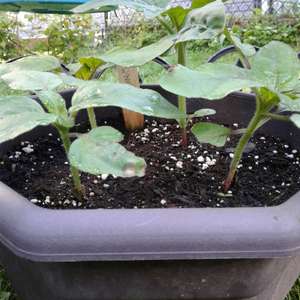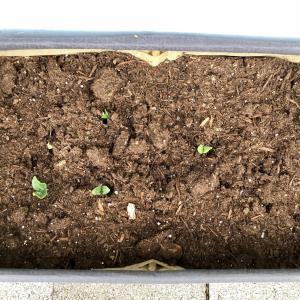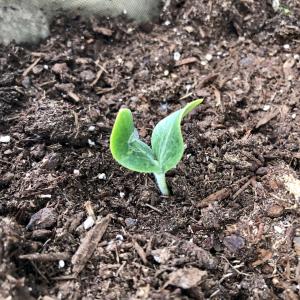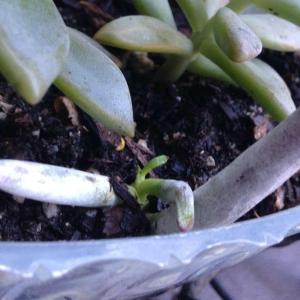文章
Miss Chen
2018年06月18日

Description: This herbaceous perennial plant is 1-4' tall, branching occasionally. The stems are square or round, and usually pubescent where new growth occurs, becoming glabrous with age. The hairless leaves are opposite or alternate along the stems, sessile or with short petioles, and up to 4" long and ½" across. They are narrowly lanceolate in shape, and sometimes have purple veins or spots. There are 4-8 teeth per centimeter along the margin of each leaf.
From the upper axils of some of the upper leaves, there appears a single flower with a long calyx tube on a short stalk (peduncle). This calyx tube is pubescent and more or less erect, terminating in 4 lanceolate sepals that often tinted purple or pink. These sepals are a little shorter than the petals. The 4 notched petals are white or light pink, and span about 1/3" across. At the throat of the flower, there is a prominent pistil that is often knobby at the end, which is surrounded by several stamens. These flowers bloom for about a month during late summer or early fall. The calyx tube matures into an elongated seed capsule, which splits open to release a multitude of tiny seeds with small tufts of reddish brown hair. These seeds are distributed by the wind. The root system is fibrous and produces rhizomes, which enables this plant to spread vegetatively.
Cultivation: The preference is full sun to light shade, and wet to moist conditions. The soil should contain lots of organic material to retain moisture. The foliage is rather fragile and can become damaged easily. This plant tolerates occasional flooding, and prefers rather cool conditions.
Range & Habitat: The native Cinnamon Willow-Herb occurs occasionally in northern and central Illinois, but it is uncommon or absent in the southern section of the state. Its range extends further to the south than other Epilobium spp., which are usually restricted to northern Illinois. Habitats include poorly drained areas of black soil prairies, moist woodlands, woodland borders, and various kinds of wetlands, including marshes, bogs, fens, seeps, and edges of ponds, rivers, or drainage ditches. The Willow Herbs are pioneer species that thrive on some kind of disturbance, such as fire.
Faunal Associations: The flowers probably attract bees and flower flies, which seek nectar and pollen. The caterpillars of various moths eat the foliage of Willow-Herbs, including Hyles lineata (White-Lined Sphinx), Eudryas unio (Pearly Wood Nymph), Anticlea multiferata (Many-Lined Carpet), and Scythris magnabella (Scythridid Moth sp.). The seeds are too small to be of much interest to birds. The foliage is non-toxic and occasionally eaten by mammalian herbivores, but it has low food value.
Photographic Location: A poorly drained area of prairie in Meadowbrook Park, Urbana, Illinois.
Comments: The flowers are rather small-sized, but they are often produced in abundance on large plants. The most distinctive characteristic of Cinnamon Willow-Herb is the reddish brown coloration of the tufts of hair on the seeds, which is responsible for the common name of this plant. Other Epilobium spp. have tufts of hair that are white or faded brown or grey. Cinnamon Willow-Herb also has serrated leaves with 4-8 teeth per centimeter, while other Willow-Herbs have leaves with either smooth edges or fewer teeth per centimeter. An unusual characteristic of the Willow-Herbs is the long calyx-tube of the flowers, which occurs behind the petals, and eventually becomes an elongated seed capsule. It looks like a flowering stalk (peduncle), but it is actually part of the flower where the ovaries are contained. In some members of the Mustard family and miscellaneous other plants, an elongated seed capsule develops in front of the petals. This is one way to determine whether the plant in front of you is a Willow-Herb, or a quite different species of plant.
From the upper axils of some of the upper leaves, there appears a single flower with a long calyx tube on a short stalk (peduncle). This calyx tube is pubescent and more or less erect, terminating in 4 lanceolate sepals that often tinted purple or pink. These sepals are a little shorter than the petals. The 4 notched petals are white or light pink, and span about 1/3" across. At the throat of the flower, there is a prominent pistil that is often knobby at the end, which is surrounded by several stamens. These flowers bloom for about a month during late summer or early fall. The calyx tube matures into an elongated seed capsule, which splits open to release a multitude of tiny seeds with small tufts of reddish brown hair. These seeds are distributed by the wind. The root system is fibrous and produces rhizomes, which enables this plant to spread vegetatively.
Cultivation: The preference is full sun to light shade, and wet to moist conditions. The soil should contain lots of organic material to retain moisture. The foliage is rather fragile and can become damaged easily. This plant tolerates occasional flooding, and prefers rather cool conditions.
Range & Habitat: The native Cinnamon Willow-Herb occurs occasionally in northern and central Illinois, but it is uncommon or absent in the southern section of the state. Its range extends further to the south than other Epilobium spp., which are usually restricted to northern Illinois. Habitats include poorly drained areas of black soil prairies, moist woodlands, woodland borders, and various kinds of wetlands, including marshes, bogs, fens, seeps, and edges of ponds, rivers, or drainage ditches. The Willow Herbs are pioneer species that thrive on some kind of disturbance, such as fire.
Faunal Associations: The flowers probably attract bees and flower flies, which seek nectar and pollen. The caterpillars of various moths eat the foliage of Willow-Herbs, including Hyles lineata (White-Lined Sphinx), Eudryas unio (Pearly Wood Nymph), Anticlea multiferata (Many-Lined Carpet), and Scythris magnabella (Scythridid Moth sp.). The seeds are too small to be of much interest to birds. The foliage is non-toxic and occasionally eaten by mammalian herbivores, but it has low food value.
Photographic Location: A poorly drained area of prairie in Meadowbrook Park, Urbana, Illinois.
Comments: The flowers are rather small-sized, but they are often produced in abundance on large plants. The most distinctive characteristic of Cinnamon Willow-Herb is the reddish brown coloration of the tufts of hair on the seeds, which is responsible for the common name of this plant. Other Epilobium spp. have tufts of hair that are white or faded brown or grey. Cinnamon Willow-Herb also has serrated leaves with 4-8 teeth per centimeter, while other Willow-Herbs have leaves with either smooth edges or fewer teeth per centimeter. An unusual characteristic of the Willow-Herbs is the long calyx-tube of the flowers, which occurs behind the petals, and eventually becomes an elongated seed capsule. It looks like a flowering stalk (peduncle), but it is actually part of the flower where the ovaries are contained. In some members of the Mustard family and miscellaneous other plants, an elongated seed capsule develops in front of the petals. This is one way to determine whether the plant in front of you is a Willow-Herb, or a quite different species of plant.
0
0
Stefanie050674
2018年05月22日

my plants around the yard are beginning to get some growth under their belts. the yard will be so pretty in a month or two. by my 4th of July, it'll be AWESOME! THE 💣!!
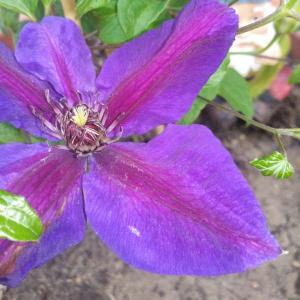

0
0
成长记
Plantlin
2018年05月21日

One of them has new growth:) Added some soil and water as most of them have roots.






1
0
文章
Miss Chen
2018年05月17日

Description: This herbaceous perennial plant is 1-3' tall, branching sparingly. It is relatively short-lived. The foliage consists of basal leaves and bolting stems with alternate leaves; most vegetative growth occurs during the spring. The stems are light to medium green, glabrous, and terete; sometimes they are slightly angular or slightly furrowed. The leaves are up to 5" long and 2" across, becoming smaller as they ascend the stems. They are usually more or less ovate, serrated or dentate along their margins, medium green, and glabrous. The basal leaves and lower alternate leaves are often pinnately lobed (pinnatifid); these lobes occur in 1-4 pairs near the base of each leaf. The upper stems terminate in erect racemes of flowers about 6-18" in length. Sometimes shorter racemes of flowers also develop from the axils of the upper leaves.
Each flower is about ¼" (6 mm.) across, consisting of 4 petals that are pale violet to nearly white, 4 pale gray or pale violet sepals, 6 stamens with violet anthers, and a pistil with a stout style. The petals are oblanceolate in shape and longer than the sepals. The sepals are oblong in shape and usually glabrous, although the tips of sepals on young flowers are sometimes finely hairy. The pedicels of the flowers are about 6-8 mm. long, ascending, and glabrous; they are green, greenish violet, or violet. The rachises (central stalks) and peduncles (basal stalks) of the racemes are green or purplish green and glabrous. The blooming period occurs during the early summer and lasts about 3 weeks. The flowers are often fragrant, particularly in sunny locations. The flowers are replaced by glabrous siliques (narrowly cylindrical seedpods) that become about ½–1" long at maturity. Each silique contains a single row of oblongoid seeds. Immature siliques are green to dark violet. The root system consists of a taproot. This plant spreads by reseeding itself.

Cultivation: The preference is partial sun to medium shade, wet to moist conditions, and rich loamy soil with abundant organic matter. This plant is able to tolerate temporary flooding.
Range & Habitat: The native Purple Rocket occurs occasionally in east central and NE Illinois, while in other areas of the state it is uncommon or absent (see Distribution Map). Habitats include wet to mesic deciduous woodlands, particularly in floodplain areas along rivers and low-lying areas that are prone to occasional flooding. This plant also occurs in soggy meadows near wooded areas, including sunny areas that are adjacent to small streams and drainage ditches. Purple Rocket is a non-weedy member of the Mustard family that usually occurs in higher quality natural areas, less often at degraded sites.

Faunal Associations: There is very little information about floral-faunal relationships for this species. In sunny areas, the nectar of the flowers attracts bees and butterflies; in particular, the butterfly Pieris rapae (Cabbage White) is strongly attracted to the flowers. In shady areas, the flowers appear to attract about the same number of bees, but fewer butterflies.
Photographic Location: Along a drainage ditch in a moist meadow at Judge Webber Park in Urbana, Illinois. This meadow is rather weedy and located near a wooded area. Purple Rocket also occurs in damp shady areas at Busey Woods in the same city.

Comments: This is one of the more unusual members of the Mustard family because it is native, non-weedy, and has pale violet flowers. As these flowers become older, their color fades to white. In sunny areas, the elongated racemes of flowers can become exceptionally long – often comprising the upper half of the plant, if not more. However, they tend to be a little shorter and less showy in shady areas. Purple Rocket (Iodanthus pinnatifidus) is fairly easy to identify in the field because it doesn't closely resemble any other member of the Mustard family. Perhaps the most similar species is Blue Mustard (Chorispora tenella). This introduced species is rare in Illinois; it differs from Purple Rocket in having pink or purplish pink flowers and glandular hairs on its stems and pedicels. The siliques of Blue Mustard curve upward and they have longer beaks. Another member of the Mustard family, the introduced Dame's Rocket (Hesperis matronalis), has much larger flowers that are rosy pink. The petals of its flowers are well-rounded and overlapping, while the petals of Purple Rocket are more narrow and don't overlap.
Each flower is about ¼" (6 mm.) across, consisting of 4 petals that are pale violet to nearly white, 4 pale gray or pale violet sepals, 6 stamens with violet anthers, and a pistil with a stout style. The petals are oblanceolate in shape and longer than the sepals. The sepals are oblong in shape and usually glabrous, although the tips of sepals on young flowers are sometimes finely hairy. The pedicels of the flowers are about 6-8 mm. long, ascending, and glabrous; they are green, greenish violet, or violet. The rachises (central stalks) and peduncles (basal stalks) of the racemes are green or purplish green and glabrous. The blooming period occurs during the early summer and lasts about 3 weeks. The flowers are often fragrant, particularly in sunny locations. The flowers are replaced by glabrous siliques (narrowly cylindrical seedpods) that become about ½–1" long at maturity. Each silique contains a single row of oblongoid seeds. Immature siliques are green to dark violet. The root system consists of a taproot. This plant spreads by reseeding itself.

Cultivation: The preference is partial sun to medium shade, wet to moist conditions, and rich loamy soil with abundant organic matter. This plant is able to tolerate temporary flooding.
Range & Habitat: The native Purple Rocket occurs occasionally in east central and NE Illinois, while in other areas of the state it is uncommon or absent (see Distribution Map). Habitats include wet to mesic deciduous woodlands, particularly in floodplain areas along rivers and low-lying areas that are prone to occasional flooding. This plant also occurs in soggy meadows near wooded areas, including sunny areas that are adjacent to small streams and drainage ditches. Purple Rocket is a non-weedy member of the Mustard family that usually occurs in higher quality natural areas, less often at degraded sites.

Faunal Associations: There is very little information about floral-faunal relationships for this species. In sunny areas, the nectar of the flowers attracts bees and butterflies; in particular, the butterfly Pieris rapae (Cabbage White) is strongly attracted to the flowers. In shady areas, the flowers appear to attract about the same number of bees, but fewer butterflies.
Photographic Location: Along a drainage ditch in a moist meadow at Judge Webber Park in Urbana, Illinois. This meadow is rather weedy and located near a wooded area. Purple Rocket also occurs in damp shady areas at Busey Woods in the same city.

Comments: This is one of the more unusual members of the Mustard family because it is native, non-weedy, and has pale violet flowers. As these flowers become older, their color fades to white. In sunny areas, the elongated racemes of flowers can become exceptionally long – often comprising the upper half of the plant, if not more. However, they tend to be a little shorter and less showy in shady areas. Purple Rocket (Iodanthus pinnatifidus) is fairly easy to identify in the field because it doesn't closely resemble any other member of the Mustard family. Perhaps the most similar species is Blue Mustard (Chorispora tenella). This introduced species is rare in Illinois; it differs from Purple Rocket in having pink or purplish pink flowers and glandular hairs on its stems and pedicels. The siliques of Blue Mustard curve upward and they have longer beaks. Another member of the Mustard family, the introduced Dame's Rocket (Hesperis matronalis), has much larger flowers that are rosy pink. The petals of its flowers are well-rounded and overlapping, while the petals of Purple Rocket are more narrow and don't overlap.
0
0
成长记
MrsMissy3477
2018年05月15日

Day 4. Drizzled a bit of hydrogen peroxide on a tiny bit of fungal growth on surface of soil. Fixed it right up!

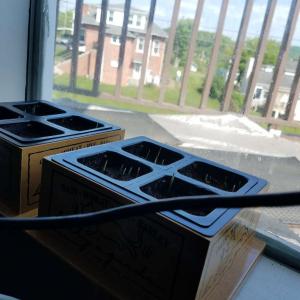


1
0
文章
Miss Chen
2018年04月28日

Most garden vegetables prefer well-drained loamy soil with a neutral pH. However, in many parts of North America, especially the Appalachian Mountains and other hilly regions, good drainage can be difficult to find. Clay soils produce stunted growth and encourage fungal diseases, such as root rot. Amending your soil with additives or choosing vegetables that grow well in this type of soil increase your chances of a healthy, productive garden.

Potatoes
According to the English Gardening website, potatoes are a traditional crop for breaking up clay soils. These plants grow in a wide range of soils, although they prefer gardens high in organic matter with a relatively acid pH. Adding compost or other organic material improves potato yields and ashes or peat decreases pH, since alkaline soils lead to potato scab disease. Potatoes reduce compaction in your clay-soil garden, making the environment friendlier for other vegetables. Avoid early varieties, as clay soils stay colder in spring than other soil types.

Peas
These plants grow well in just about any soil from clay to sand, as long as they have adequate drainage. They prefer slightly acidic to slightly alkaline soils with pH from pH 6 to pH 7.5. However, they will grow in soils with stronger acidity or alkalinity. Avoid overwatering when growing peas on clay, as too much water encourages wilt and root rot diseases. After harvest, cut the plants at soil level, leaving the roots in the ground to add nitrogen and organic material to the soil. This improves drainage and soil quality.

Cabbage
Cabbage and other members of the Brassica family grow well in soils ranging from loam to silty clay. They tolerate intermediate levels of salt, which sometimes build up in clay soils after extensive fertilizer use. They grow best in the cool season. As with potatoes, choose cabbages and cabbage relatives that grow during the late spring and summer, as clay soils often remain too cold for early planting.
Considerations
Even plants that do well in clay soil prefer good drainage and high fertility. Amending your clay-based soil makes it friendlier to clay-loving garden vegetables and improves yield. Adding organic materials, such as compost, manure and peat, gives your soil better nutrition and reduces the chance of water pooling. Include grass clippings, dead garden plants and organic yard waste in the fall to compost over the winter. Avoid adding sand, since the result actually compacts more easily and firmly than clay alone.

Potatoes
According to the English Gardening website, potatoes are a traditional crop for breaking up clay soils. These plants grow in a wide range of soils, although they prefer gardens high in organic matter with a relatively acid pH. Adding compost or other organic material improves potato yields and ashes or peat decreases pH, since alkaline soils lead to potato scab disease. Potatoes reduce compaction in your clay-soil garden, making the environment friendlier for other vegetables. Avoid early varieties, as clay soils stay colder in spring than other soil types.

Peas
These plants grow well in just about any soil from clay to sand, as long as they have adequate drainage. They prefer slightly acidic to slightly alkaline soils with pH from pH 6 to pH 7.5. However, they will grow in soils with stronger acidity or alkalinity. Avoid overwatering when growing peas on clay, as too much water encourages wilt and root rot diseases. After harvest, cut the plants at soil level, leaving the roots in the ground to add nitrogen and organic material to the soil. This improves drainage and soil quality.

Cabbage
Cabbage and other members of the Brassica family grow well in soils ranging from loam to silty clay. They tolerate intermediate levels of salt, which sometimes build up in clay soils after extensive fertilizer use. They grow best in the cool season. As with potatoes, choose cabbages and cabbage relatives that grow during the late spring and summer, as clay soils often remain too cold for early planting.
Considerations
Even plants that do well in clay soil prefer good drainage and high fertility. Amending your clay-based soil makes it friendlier to clay-loving garden vegetables and improves yield. Adding organic materials, such as compost, manure and peat, gives your soil better nutrition and reduces the chance of water pooling. Include grass clippings, dead garden plants and organic yard waste in the fall to compost over the winter. Avoid adding sand, since the result actually compacts more easily and firmly than clay alone.
0
0
文章
Miss Chen
2018年04月16日

Growing vegetables in your home garden requires a certain amount of attention to soil condition and pH level. The pH level of soil can critically affect the growth of vegetables, allowing (or preventing) roots to take up sufficient nutrition for the production of the flowers and fruit. If you live in a region with acidic soil, selecting vegetables that thrive in acidic soil will bring you a better harvest.

Potatoes
Potatoes (both Irish potatoes and sweet potatoes) prefer acidic soil conditions. The ideal pH range for this crop is 4.8 to 5.5, according to the Cornell University Vegetable Growing Guide. Potatoes need a light, loose, well-draining soil that is high in organic matter. To add nutrients and help aerate the soil, work in soil amendment such as peat moss, compost or manure at planting time. Avoid adding too much nitrogen-rich fertilizer, which will encourage the potato plants to grow foliage at the expense of tuber production.
Eggplant
Eggplants also grow well in slightly acidic soil (pH level between 5.5 and 7.5). The eggplant is a heat-loving plant that requires full sun and frost-free temperatures. The crop will benefit from the addition of compost or manure to increase the amount of organic matter in the soil. Mulching plants helps to keep down weeds and retain moisture.
Tomatoes
Tomatoes prefer a slightly acidic soil with a pH range of 6.2 to 6.8, according to the University of Rhode Island Landscape Horticulture Program. A loamy, well-draining soil that is rich in organic matter will help tomato plants grow and produce. Tomatoes also benefit from the application of fertilizer that contains phosphorus, but fertilizer with too much nitrogen can inhibit fruit production. A 5-10-10 or 5-20-20 fertilizer is recommended. These numbers designate the percentages of nitrogen, phosphorus and potassium in the fertilizer formula. Nitrogen is always the first number in the formula, phosphorus is the second and potassium is the third.

Green Peppers
Green peppers can be grown in slightly acidic soil in the range of 6.0 to 6.8. They require well-draining soil with moderate fertility for best results. Peppers are warm season vegetables that will experience blossom drop if exposed to night temperatures below 60 degrees Fahrenheit. They will also suffer from poor fruiting if the blossoms develop into the fruit (called "fruit setting") when temperatures are above 80 degrees Fahrenheit during the day, according to Ohio State horticulturist Marianne Riofrio.
Squash
Squash will grow in acidic soils with a pH range of 5.5 to 6.8, according to the University of Connecticut website. Add compost or manure at planting time to condition the soil and retain moisture. Mulching helps to control weeds that compete for nutrients with the squash plants. Do not mulch with grass clippings from lawns that have been treated with an herbicide.
Kale
Kale prefers soil in the pH range of 6.0 to 7.0 for best growth, according to the University of Rhode Island Landscape Horticulture Program. Kale is a cool weather crop that prefers daytime temperatures of 65 to 80 degrees Fahrenheit. Mulching will help to keep roots cool and free of weeds.

Potatoes
Potatoes (both Irish potatoes and sweet potatoes) prefer acidic soil conditions. The ideal pH range for this crop is 4.8 to 5.5, according to the Cornell University Vegetable Growing Guide. Potatoes need a light, loose, well-draining soil that is high in organic matter. To add nutrients and help aerate the soil, work in soil amendment such as peat moss, compost or manure at planting time. Avoid adding too much nitrogen-rich fertilizer, which will encourage the potato plants to grow foliage at the expense of tuber production.
Eggplant
Eggplants also grow well in slightly acidic soil (pH level between 5.5 and 7.5). The eggplant is a heat-loving plant that requires full sun and frost-free temperatures. The crop will benefit from the addition of compost or manure to increase the amount of organic matter in the soil. Mulching plants helps to keep down weeds and retain moisture.
Tomatoes
Tomatoes prefer a slightly acidic soil with a pH range of 6.2 to 6.8, according to the University of Rhode Island Landscape Horticulture Program. A loamy, well-draining soil that is rich in organic matter will help tomato plants grow and produce. Tomatoes also benefit from the application of fertilizer that contains phosphorus, but fertilizer with too much nitrogen can inhibit fruit production. A 5-10-10 or 5-20-20 fertilizer is recommended. These numbers designate the percentages of nitrogen, phosphorus and potassium in the fertilizer formula. Nitrogen is always the first number in the formula, phosphorus is the second and potassium is the third.

Green Peppers
Green peppers can be grown in slightly acidic soil in the range of 6.0 to 6.8. They require well-draining soil with moderate fertility for best results. Peppers are warm season vegetables that will experience blossom drop if exposed to night temperatures below 60 degrees Fahrenheit. They will also suffer from poor fruiting if the blossoms develop into the fruit (called "fruit setting") when temperatures are above 80 degrees Fahrenheit during the day, according to Ohio State horticulturist Marianne Riofrio.
Squash
Squash will grow in acidic soils with a pH range of 5.5 to 6.8, according to the University of Connecticut website. Add compost or manure at planting time to condition the soil and retain moisture. Mulching helps to control weeds that compete for nutrients with the squash plants. Do not mulch with grass clippings from lawns that have been treated with an herbicide.
Kale
Kale prefers soil in the pH range of 6.0 to 7.0 for best growth, according to the University of Rhode Island Landscape Horticulture Program. Kale is a cool weather crop that prefers daytime temperatures of 65 to 80 degrees Fahrenheit. Mulching will help to keep roots cool and free of weeds.
0
0
文章
Miss Chen
2018年04月12日

Romaine lettuce (Lactuca sativa), also called cos lettuce, makes a rather elegant statement in containers with its upright growth habit and narrow leaves. Well-suited for containers, romaine can grow alone, with other types of lettuce such as looseleaf, butterhead or crisphead, or in combination with colorful flowering plants. Grow a single plant in a 2-gallon pot or several plants in a 12-inch container. Numerous varieties exist; try combining cultivars with different leaf colors and plant heights.

Container Choices
Although a romaine lettuce can grow in containers as small as a 4-inch pot, growth is optimum in larger containers where the soil doesn't dry as fast and there's room for root growth. Begin with clean containers with multiple drainage holes. Wash used pots in hot, soapy water and rinse well. Soak pots for at least five minutes in a mixture of 1 part household bleach to 9 parts water; rinse well and let dry. Plastic pots are easier to keep clean than clay pots, weigh less and prevent the roots from drying out too quickly.
Light Requirements
Lettuce grows well in sun but can tolerate partial shade, although heads may not be as tightly furled. In hot summer areas, consider moving containers of romaine into partial shade as temperatures warm. Romaine is more tolerant of heat and slower to bolt - or form flower stalks - than other kinds of lettuce, but it will produce longer if protected from hottest exposures.
When to Grow
Romaine is basically a cool season annual plant. In cold winter areas, it grows best in spring and again in fall. In mild winter climates, grow it in fall, winter and spring. Sow the seeds directly in the container 1/4 inch deep and 1 inch apart. Keep the soil moist but not soggy. Thin seedlings after they germinate to the strongest seedlings spaced 6 to 8 inches apart, depending on the cultivar.
Soil and Water
Use a well-draining mix rich in organic material such as a quality soilless potting mix. Keep the soil evenly moist. For container lettuce, this might mean watering every day or every other day because soil in containers dries out more quickly than in garden beds. Romaine is sweeter-tasting than other lettuces, but lettuces can become bitter if the soil is allowed to dry.

Fertilizer Needs
Frequent, light fertilizing throughout the growing season helps develop rapid growth of full, crispy leaves, important if you're continually harvesting outer leaves or if you're using the cut-and-come-again method, where you cut the whole plant off above the soil line, leaving the base to sprout new small heads. Use a product such as 8-4-4 at the rate of 1 tablespoon per gallon of water. Every seven to 10 days, apply fertilizer to the container's soil until the solution comes out of the drainage holes.
Romaine Cultivars
Fit more plants in a container by choosing smaller-growing varieties such as compact, dark green "Monte Carlo" or dark red mini romaine "Truchas." For full-sized plants, consider disease-resistant, 10- to 12-inch-tall "Parris Island Cos." For bronzy-red leaves, similar sized heirloom "Cimarron" dates back to the 1700s. The cultivar "Freckles" is showy enough for ornamental use, with light green leaves randomly splashed with burgundy. Another heirloom variety, it's also known as "Flashy Troutback."

Container Choices
Although a romaine lettuce can grow in containers as small as a 4-inch pot, growth is optimum in larger containers where the soil doesn't dry as fast and there's room for root growth. Begin with clean containers with multiple drainage holes. Wash used pots in hot, soapy water and rinse well. Soak pots for at least five minutes in a mixture of 1 part household bleach to 9 parts water; rinse well and let dry. Plastic pots are easier to keep clean than clay pots, weigh less and prevent the roots from drying out too quickly.
Light Requirements
Lettuce grows well in sun but can tolerate partial shade, although heads may not be as tightly furled. In hot summer areas, consider moving containers of romaine into partial shade as temperatures warm. Romaine is more tolerant of heat and slower to bolt - or form flower stalks - than other kinds of lettuce, but it will produce longer if protected from hottest exposures.
When to Grow
Romaine is basically a cool season annual plant. In cold winter areas, it grows best in spring and again in fall. In mild winter climates, grow it in fall, winter and spring. Sow the seeds directly in the container 1/4 inch deep and 1 inch apart. Keep the soil moist but not soggy. Thin seedlings after they germinate to the strongest seedlings spaced 6 to 8 inches apart, depending on the cultivar.
Soil and Water
Use a well-draining mix rich in organic material such as a quality soilless potting mix. Keep the soil evenly moist. For container lettuce, this might mean watering every day or every other day because soil in containers dries out more quickly than in garden beds. Romaine is sweeter-tasting than other lettuces, but lettuces can become bitter if the soil is allowed to dry.

Fertilizer Needs
Frequent, light fertilizing throughout the growing season helps develop rapid growth of full, crispy leaves, important if you're continually harvesting outer leaves or if you're using the cut-and-come-again method, where you cut the whole plant off above the soil line, leaving the base to sprout new small heads. Use a product such as 8-4-4 at the rate of 1 tablespoon per gallon of water. Every seven to 10 days, apply fertilizer to the container's soil until the solution comes out of the drainage holes.
Romaine Cultivars
Fit more plants in a container by choosing smaller-growing varieties such as compact, dark green "Monte Carlo" or dark red mini romaine "Truchas." For full-sized plants, consider disease-resistant, 10- to 12-inch-tall "Parris Island Cos." For bronzy-red leaves, similar sized heirloom "Cimarron" dates back to the 1700s. The cultivar "Freckles" is showy enough for ornamental use, with light green leaves randomly splashed with burgundy. Another heirloom variety, it's also known as "Flashy Troutback."
0
1



